Who is this?
What company are you calling from?
Why are you calling me?
No, thanks.
Not interested.
Sorry, I’m too busy.
Can you just email me some info?
We already have something in place.
Yeah, we don’t have a budget for this sort of thing.
Objections. Objections. Objections.
Cold call objections are par for the course for outbound sales reps.
But what separates the top salespeople from the average ones is how these cold call objections are handled, deflected, and turned into something that keeps the buyer on the phone and, ideally, helps book that first meeting.
Follow this 3-point framework to overcome any and all cold call objections you will face.
Bonus: We’ll also share 4 cold calling tips to avoid cold call objections entirely.
Overcome Cold Call Objections, Step #1: Validate their objection
People need validation. They need to be heard and listened to.
Give them what they need!
Instead of simply steamrolling through their objection, own it. Validate it. Fall on your sword and acknowledge their objection. This tactic is the first step in preventing a buyer from hanging up on you, ending the call seconds after they answer.
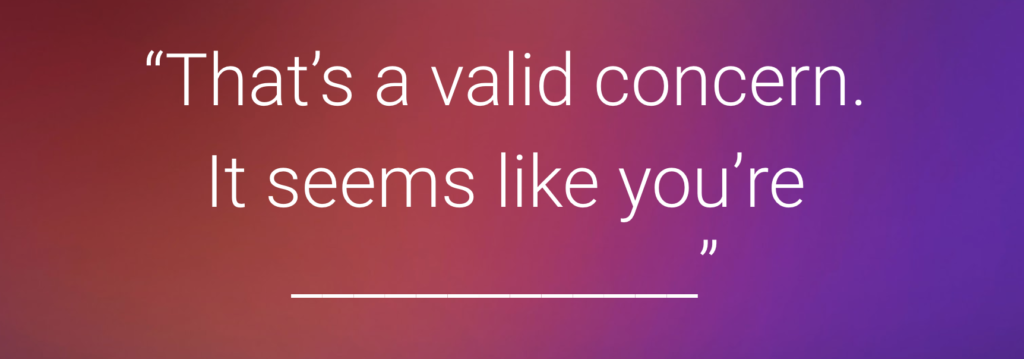
Or
- “I totally understand.”
- “That’s fair.”
- “Thanks for calling that out.”
These are all simple, direct, and reasonable ways to validate a buyer’s objection.
But validation is just the first step.
Overcome Cold Call Objections, Step #2: Labelling
Once you’ve validated the objection, it’s time to label it.
It’s not enough to just validate the buyer’s feelings and move on. That’s not enough. Instead, make your prospect feel heard but put a label on their emotions.
Note: This is an advanced selling technique. Done right, it makes buyers feel heard, understood, and (this is the key) more likely to respond positively to your follow-up ask.
“I totally understand if you’re busy right now …”
“That’s fair; it seems like you’re not the best person to speak with.”
“Thanks for calling that out; it sounds like I missed the mark.”
The italicized phrases are the label.
Another way to add a label is to include an emotion.
Like this:
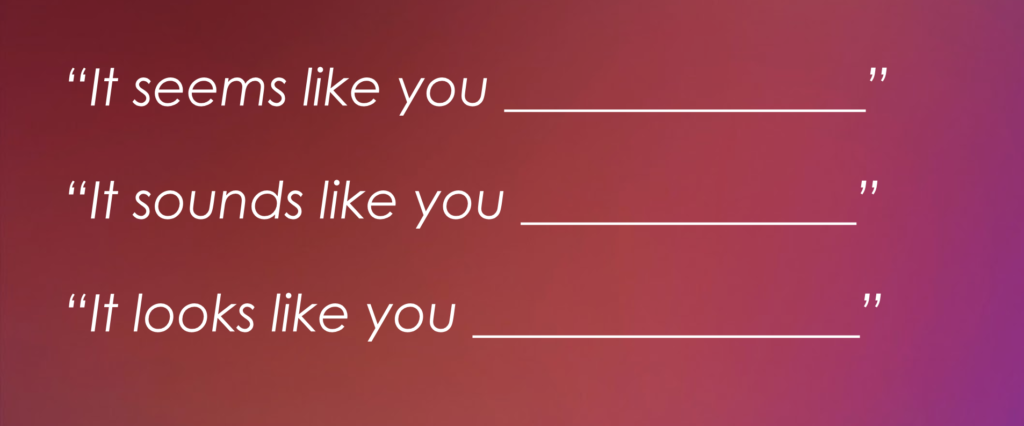
What follows after the “like you” is the emotion.
So the final product is:
- “It seems like you are overwhelmed with work.”
- “It sounds like you are feeling stressed with the responsibility.”
- “It looks like you are worried about not having enough time in the day.”
The italicized words are the emotions.
Overcome Cold Call Objections, Step #3: Follow up with a secondary ask
The key to the third part of this objection handling tactic is not to leave the conversation with nothing. Validating, then labeling, the objection is essential, but if that ends the call … you are left empty-handed.
Your job is to uncover clues that will help to keep this call alive and flowing.
Finishing with questions like:
- “When is a better time for you?”
- “Can you share with me who is in charge of projects like this at [COMPANY NAME]?”
- “Could you tell me what your main priorities are right now?”
Putting it all together in this cold calling example:
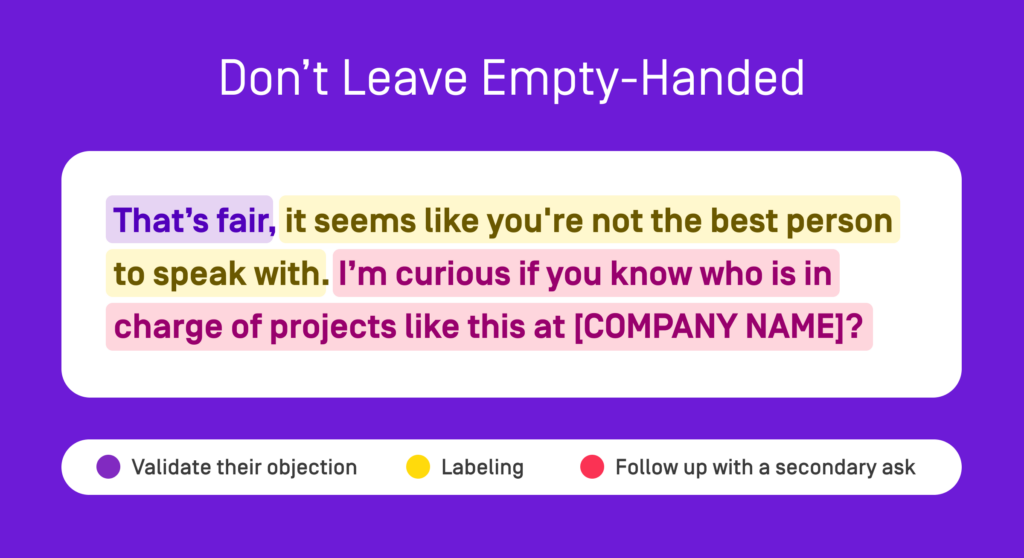
Validate their objection ✅
Label their objection ✅
Close with a secondary ask ✅
But what about skipping the whole cold call objection game entirely?
Remember: Cold calls are a beast of their own. Standard objection handling techniques don’t apply. You have limited time, or the call is done.
Avoid cold call objections by stating your full name and company name
“Hi, Sue. My name is Jonathan Costet. I’m calling from Gong in San Francisco.”
Full name. Company name.
Immediately.
Those are the first words that come out of your mouth the second you hear, “Hello.”
This is what we call “leading with intention.”
Simply put, people who introduce themselves with their full name and company name command respect.
You should always introduce yourself with your full name unless you are Madonna or The Rock or Adele or Rihanna or LeBron or Drake.
You see, stating your full name and company name from the onset puts you, the seller, in the driver’s seat; it helps you gain (and ideally maintain) control of the conversation — especially during cold calls.
If you allow your buyer to ask the questions (“Who is this? Why are you calling?”), you start the call on the defensive. Not a great place to begin.
Avoid cold call objections by stating the reason for your call
You’ve opened the cold call with your full name and company name. Perfect. Now, jump right into the reason you are calling.
Don’t overcomplicate it.
“The reason for my call is … “
This phrase means you will be 2.1x more successful in booking a meeting than if you don’t say why you’re calling:
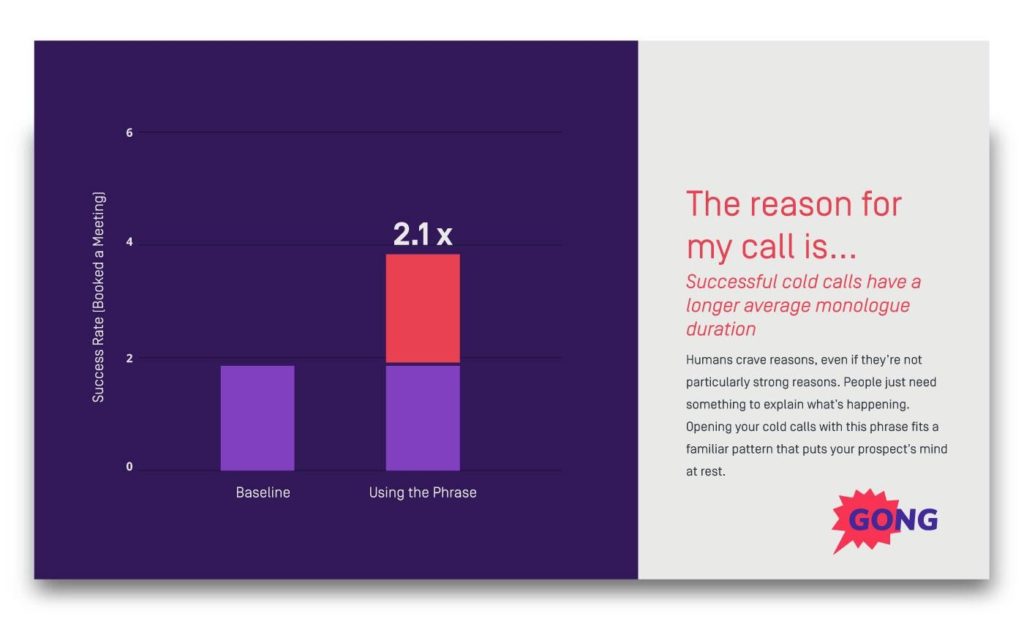
Bonus: Drop in a “how have you been” between your full name/company and “the reason for my call is … “
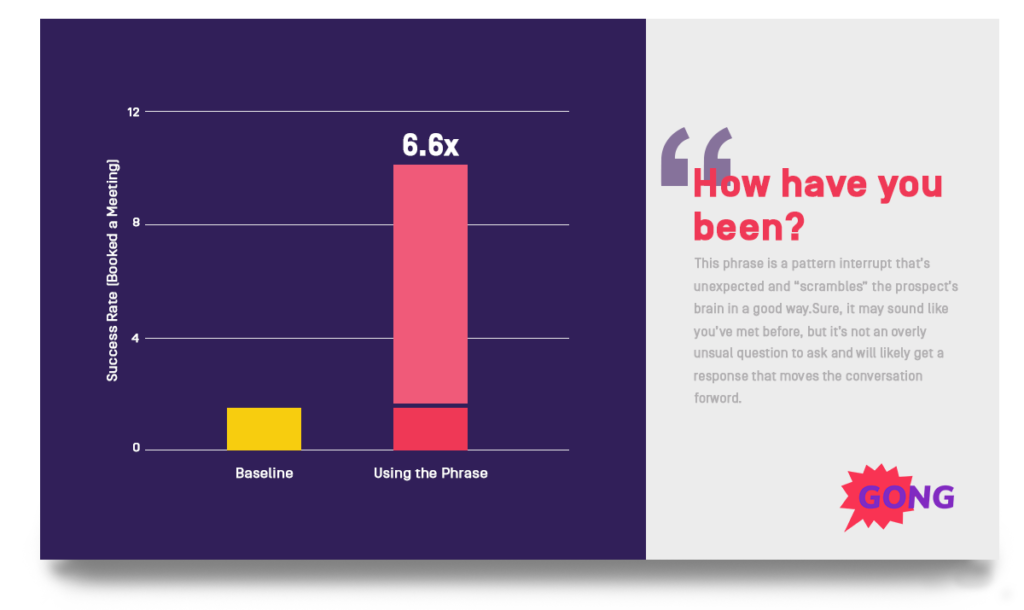
This is by far the best cold call opening line, helping increase your odds of booking a meeting by 6.6x.
Putting it all together:
“Hi, Sue. My name is Jonathan Costet. I’m calling from Gong in San Francisco. How’ve you been? The reason for my call is …”
You’ve now all but eliminated these 3 possible objections:
- Who are you?
- What company are you calling from?
- Why are you calling me?
Avoid cold call objections by asking for permission
One of the best ways to avoid cold call objections? Don’t give your buyer the chance to object.
Seems obvious, right?
If your first question is, “Did I catch you at a bad time?” (a recommended tactic in many-a-sales books), you are less likely to book a meeting — 40% less likely, to be exact.
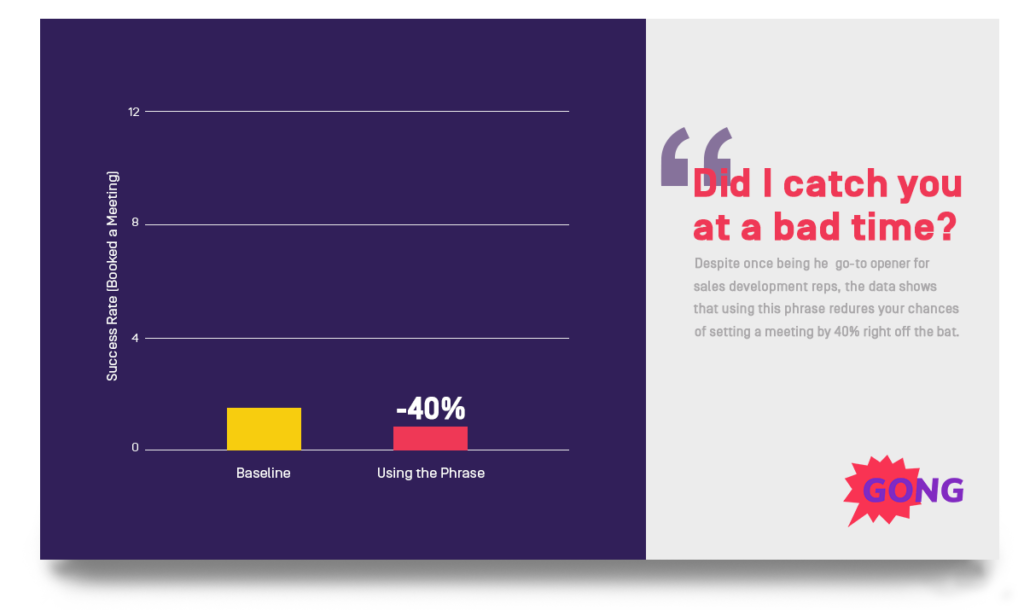
Cold calls that used this opening line had a terrible 0.9% success rate.
Instead, try this:
“I know I’m calling you out of the blue but would you be willing to learn more about how we help sales leaders close more deals? If what I’m sharing with you isn’t relevant, you can hang up on me – sound fair?”
The last part (italicized) is how you keep them on the horn.
Avoid cold call objections by using an interest CTA
Seller: “What is your availability for later this week?”
Buyer: “I can’t this week.”
And … conversation over.
Remember, cold call objections are different from run-of-the-mill sales objections.
One wrong move and it’s Game Over.
That type of CTA is called an “open-ended CTA” — you ask for a meeting but don’t toss out an exact date or time. Another common CTA is the “specific CTA.” As it sounds, this one is asking for a meeting using a specific date and time (“Are you available to meet on Tuesday at 4 PM PT?”)
There is a time and a place for open-ended and specific CTAs — just not in cold calls.
For cold calls (and emails), the interest CTA beats out specific CTAs every time. Again, this is because you are selling the conversation, not selling the meeting.
Try this approach as your call to action: “Does it make sense for me to give you more detail about how we do that?”
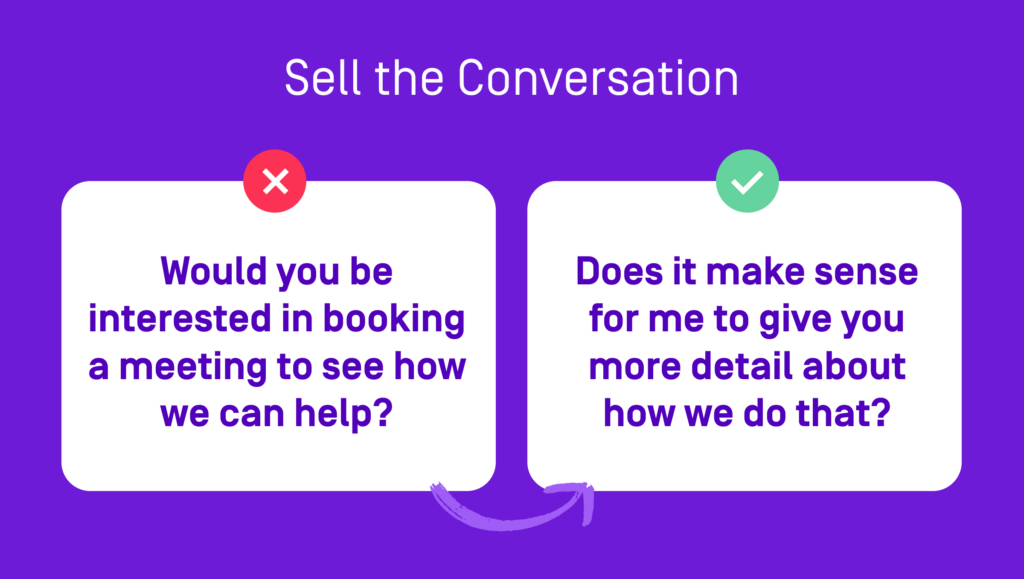
Steal these scripts
You now have the necessary tactics to move from cold call to booked meeting — with data to back it all up.
Now it’s time for some cold calling scripts to help support your efforts.
These cold calling scripts were generated based on data from over 100,000 cold calls.
And they are yours. For free. Have at ‘em.
